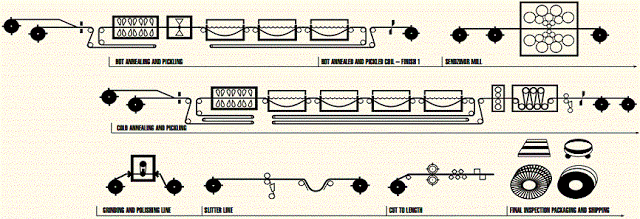PRODUCT CATEGORY
CONTACT US
- Tel: 0086-311-89642206
- Fax: 0086-311-67906676
- Mobile: 0086-15076331069 13933856228
- E-mail: sales@hbmetals.com
- E-mail: info@hbmetals.com
Stainless Steel Sheet / Plate: Hot Rolled and Cold Rolled
1. Hot Rolling Process for Stainless Steel Sheet/Plate/Strip
The raw material(steel scrap) is first tipped into the Electric Arc Furnace(EAF). The heat generated by arc current melts the steel scrap inside. During this process, chromium and nickel metals are also added. The molten steel is poured to a ladle. Then it is transferred to the Argon Oxygen Decarburization(AOD) converter to reduce the carbon content. During and after the carbon removal, some other necessary alloy additions are made to fine tune the stainless steel chemical composition. Finally, the molten steel is poured into modern Continuous Casting Machine(CCM) where it is cooled down by water spray and the stainless steel becomes solidified slabs.
As semi-finished products, stainless steel slabs should be descaled first and then be heated in the Reheating Furnace until they are red hot(around 1200℃). The roughing stand is the first step of hot rolling where the hot slabs are rolled forwards and backwards several times to gradually form a basic shape of finished flat piece. After leaving the roughing stand, the slabs are passed through the Finishing Stand which is also known as Steckel Mill. Except for the backwards and forwards rolling, it turns the slab 90 degrees and roll the sideways during the process. The Steckel Mill is a reversing mill with a heating furnace and other auxiliaries. Final thicker stainless steel plates will be pickled, straightened and packaged. Stainless steel coils can be acquired after the much thinner sheet running through the rolling slitter.
2. Cold Rolling Process for Stainless Steel Sheet / Coil
Generally, the raw material of cold rolling is hot rolled stainless steel coil. The hot-rolled stainless steel coil should be first decoiled, pickled and descaled for the preparation of following procedures. Then it is fed to famous Sendzimir Mills(Z-Mills) for cold rolling. In this step, the stainless steel sheet passes through a series of rolling mill stands which squeeze the sheet to reduce its thickness in the cold state. Cold rolling causes hardening of the stainless steel, so a subsequent cold annealing & pickling process is required to soften it. Following grinding and polishing jobs are to improve the surface quality of the sheet. Finally, cold rolled stainless steel sheet or strip runs through the slitter line forming coils which will be carefully inspected, marked, packaged and socked.
3. Differences Between Hot Rolled and Cold Rolled
Cold rolled stainless steel sheet has more accurate dimensional tolerances than that of hot rolled. Unless taking subsequent pickling or descaling treatment, hot rolled stainless steel sheet comes with a rough grey finish while cold rolled has a shinny whitish surface finish. From an economic view, cold rolled stainless steels are more expensive than hot rolled ones. Hot rolled has better ductility and malleability while cold rolled is harder and has more strength.
See the specification of stainless steel sheet/plate/coil we have in stock.
Views: Author:hbmetals Date:15/07/03











